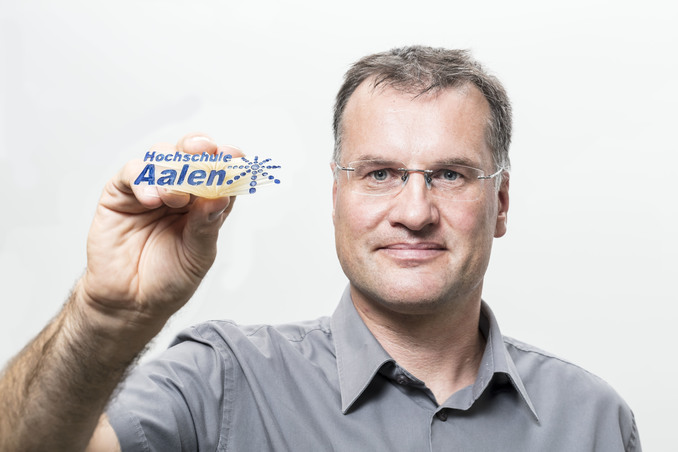Photonics Research on the RiseThe German Research Foundation is funding 3D-printing at Aalen University

Prof. Dr. Andreas Heinrich from the Centre for Optical Technologies is excited about receiving funding from the DFG.
Two new projects in the fields of additive manufacturing and form fitting of optical components at the Centre for Optical Technologies of Aalen University. Paramount to the project is the development of new, potentially groundbreaking technologies. The results of the fundamental research should subsequently be used in various applications, and when possible, further developed into marketable commodities with companies in the region.
New production techniques and technologies are usually the beginning of developing innovative products, which can compete on the market either due to additional functions or a markedly lower price. At the Centre for Optical Technologies (ZOT) of Aalen University, new production and measuring techniques in the field of optical engineering have been researched for more than 15 years, and with great success. Past achievements include contributions to developing new energy-efficient LED-lighting systems or cost-efficient plastic protective goggles. A relatively new research activity is the three-dimensional printing (3D-printing) of optical components.
High Requirements to Receive Funding through the DFG
The German Research Foundation DFG funds fundamental research characterized by high quality and uncharted scientific territory. Usually, only every third project proposal receives funding, due to the limited amount of funds. For that reason, it is a success for both the ZOT and the university, that two projects will soon be funded with a total of 1.2 million Euros. The project director Professor Dr. Andreas Heinrich is excited: “For us, this means a special recognition of our work. With the funding, we can cover the entire spectrum from fundamental research to application-oriented research. The younger researchers will benefit from it too, because we can now offer more ambitious topics for doctor theses.”
Printing in New Dimensions: 3D is Old News
Together with the professors Rainer Börret and Harald Riegel, the project 6D-printing is developing a robot-based additive manufacturing platform. What is special about this platform is the design of three modules: Module 1 includes a flexible 3D-printing unit, integrated into a robot with six degrees of freedom. This means that the printing head does not only move in three directions (x, y, z), but can also turn on three axles. This allows for flexibly constructing concaved optical components like contact lenses, as well as from two different materials, or printing already existing components. Module 2 is made up of a laser structuring unit, which can change the surface of 3D-printed layers, and in this way change the refraction index, for example. The third module can accommodate various measuring systems for real-time control of printing and structuring, and in this way can help provide data to avoid faulty printed products. The challenge is integrating all three modules into a functioning system. The production platform should then be applied to various research questions in cooperation with renowned research institutions like the Leibniz Institute for New Materials in Saarbrücken, the Institute of Applied Optics at the University of Stuttgart, the research Group for photonic materials at Paderborn University or the Institute for Laser Technologies ILM from Ulm.
Individual Fitting of Microlenses
The second project deals with the individual form fitting of microlenses with the help of electrical fields. There, an inkjet printer is used to create single droplets from liquid plastic in the form of concave microlenses. Additionally, this form and its characteristics can be changed by applying electrical fields, and the new form can then be conserved by hardening the plastic and with UV-lights. The whole process will be observed via sensors. The goal here is to develop models that can predict the optical characteristics of microlenses. Using this process in the region is important to the doctoral physicist Heinrich: “We are researching very promising future technologies with huge potential for various fields. We want to bring these to our established regional networks of companies and research institutions like the SmartPro Partnership. Additionally, we want to attract new cooperation partners with this project as well.”
Further information can be found here: https://hs-aalen.de/zot
Contact person: Prof. Dr. Andreas Heinrich (andreas.heinrich@hs-aalen.de)
